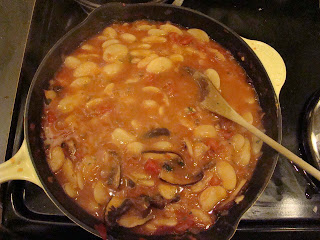The Goods*:
1 lamb sausage link (about 1/4 lb)
3 medium-large parsnips
1 large portabella mushroom cap
1/2 medium yellow onion
1 tbsp clarified butter**
1 clove garlic
1 large handful fresh cilantro, stems included
1 tsp tomato paste
1 tsp ground coriander
1 tsp ground cumin
Sauce
1 cup water
1 tsp cilantro
2 tsp lemon juice
1 tsp salt
1 tsp butter
1 tsp AP flour
Set a large, well-salted pot on high heat to boil. Wash and dry the parsnips. Trim off the heads. Finely dice the parsnips (see below). Once the water comes to a boil, add the parsnip cubes. Boil the parsnips for 5 minutes. Drain in a colander and set aside.
Slice the mushroom cap as finely as possible while still keeping the thickness even. Heat a few spritzes of olive oil on medium in a large sauté pan. Working in small batches, sear the mushroom slices. They should need about 1 minute per side. Season with kosher salt and pepper, then set aside the cooked mushrooms.
Add some (roughly one quarter) of the clarified butter to the same skillet and raise the heat to medium high. Pan fry the boiled parsnips in small batches. It is important not to crowd the pan or they will burn. Each batch should cook for roughly 3 minutes, or until some brown color develops. Set aside the browned parsnips.
Finely dice the onion half. Remove the skin from the sausage link and crumble the meat, along with some olive oil, into the same sauté pan on medium heat. After a few minutes, add the onion. Once the onion is translucent and the meat appears mostly cooked, add the garlic, cumin, and coriander. After another minute or so, deglaze the pan with 1/2 a cup of water. Add the tomato paste. Cook for a few more minutes.
Preheat the oven to 350 F. Line the bottom of four ramekins with the mushroom slices (see below). Finely chop the cilantro. In a large mixing bowl, combine the parsnips, onion/lamb mixture, and the cilantro. Mix well. Pack the mixture into the ramekins. Using an appropriately sized drinking glass, press the mixture down within each ramekin. Bake for 10 minutes.
Place the same skillet back on medium heat. Finely chop the cilantro. Add the water, cilantro, salt, and lemon juice. In a small bowl, cream the butter with the flour. Once the water in the pan is bubbling, add the butter/flour mixture to thicken the sauce. When the ramekins are finished, invert onto a plate and serve with the sauce. Two ramekins should feed one person.

Parsnip dicing diagram

The seared mushroom slices.

Mushrooms in the ramekins.

The lamb meets the parsnips.

The finished product!
*This was the result of yet another attempt to scrounge together dinner without another trip to the grocery store. I had a few parsnips on hand, a portabella mushroom cap, some fresh cilantro, and this lovely lamb sausage, in the hot Italian style, from Stillman's Farm.
**High-heat friendly oil can be substituted here.














